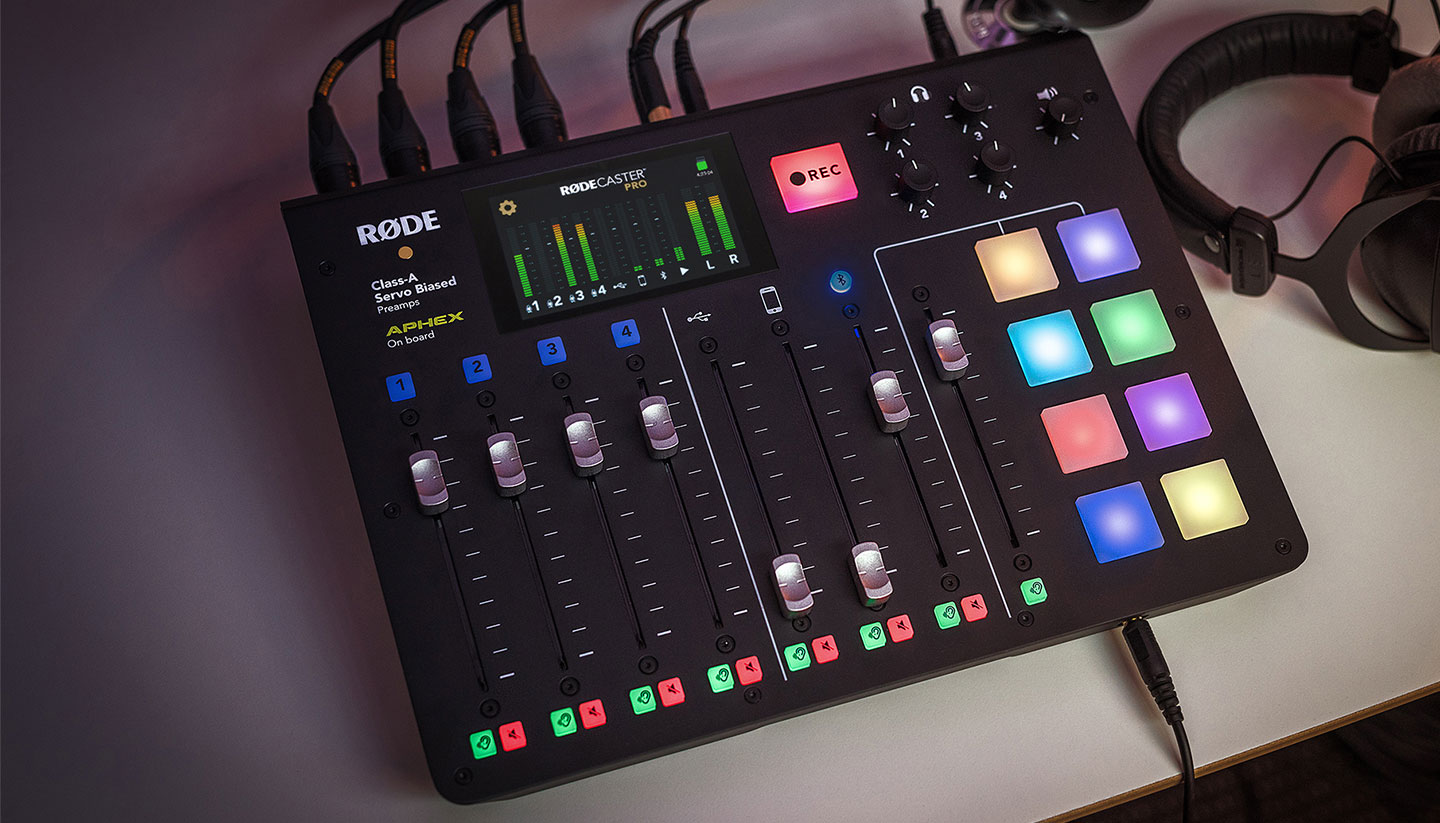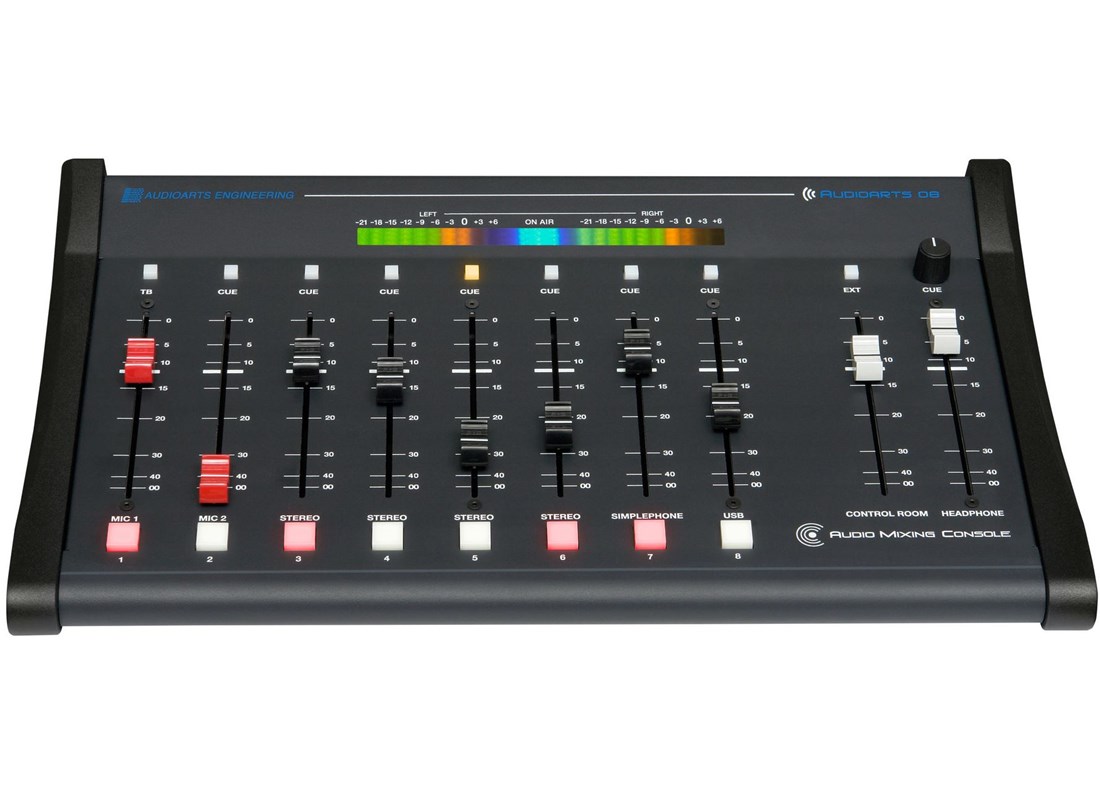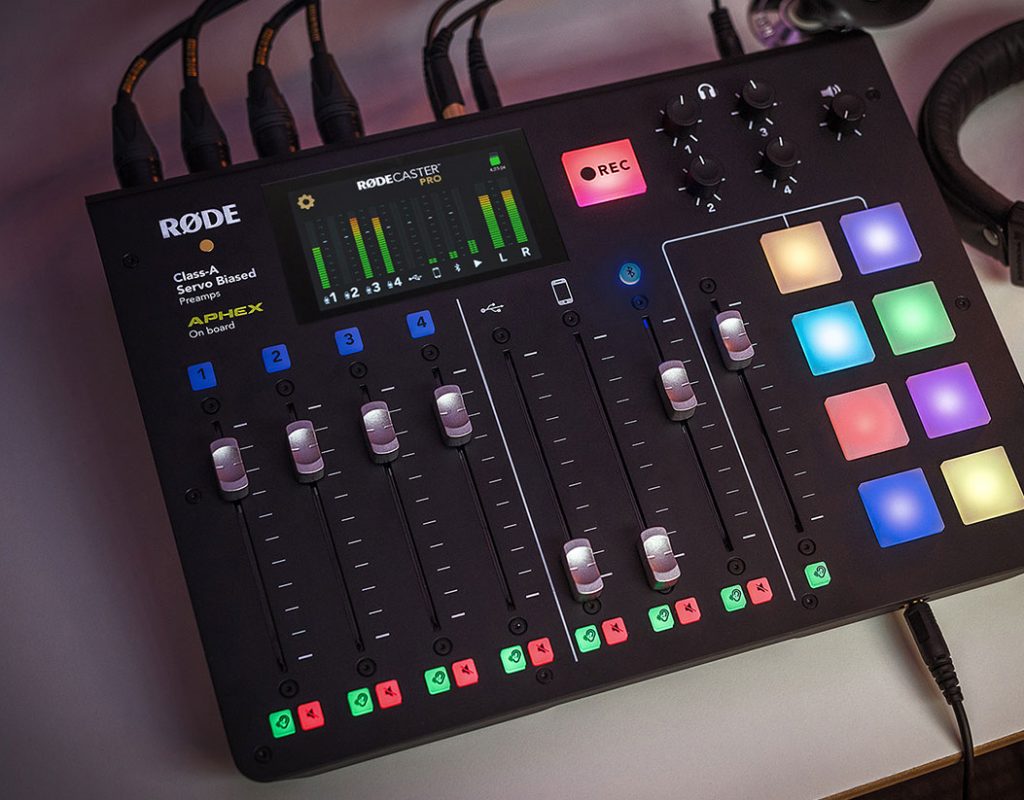
The ideal tools for LIVE production and broadcast are often different from those used for the opposite production process, which is heavily focused on a time-consuming MULTITRACK post-production workflow. There are many audio production mixers for both types of production, although there are fewer options on the market that are truly optimized for LIVE broadcast/production. When I use the term LIVE in this article, I am referring to both true live (where most of the broadcast actually takes place as words are spoken, and we can take truly live, spontaneous phone calls from listeners/viewers) and simulated live, sometimes called live-to-drive or previously live-to-tape, where classic radio shows like Car Talk had simulated live phone calls, which were actually callbacks recorded during the week and edited. Possible applications for RØDECaster Pro go way beyond just audio podcasting (which by definition is pre-recorded and RSS-subscribed). The RØDECaster Pro also fits perfectly for live radio (be it live Internet radio or conventional AM/FM/satellite radio) and even for live TV (be it live Internet TV or conventional UHF/VHF/cable/satellite). This article will clarify all the reasons why the RØDECaster Pro is ideal for LIVE production —together with pre-produced segments, and why many other audio mixers made for MULTITRACK production are not ideal for live production, especially when the show host is also the audio mixer operator. This article will also compare the RØDECaster Pro with some older LIVE audio mixers that many critics apparently never knew about.
Benefits of multitrack and potentially evergreen content
Multitrack offers us the maximum control to isolate each sound source, so we can crossgate, equalize, normalize and compress each one individually. The classic case of blocking out someone’s sneeze which interrupted someone else’s epic soundbite is absolutely valid, but costly in post-production time.
Benefits of LIVE and its potentially evergreen content
LIVE is reality, with all of its adrenaline, spontaneity and imperfections. LIVE allows us to take live phone calls (screened or unscreened). When somebody sneezes or coughs, it’s reality (unless that person has a mute button). When it’s TRULY LIVE, you can say the date and time without ruining the illusion of LIVE for an on-demand performance later. But even if we choose to make the once LIVE event available as on-demand, it can still be potentially evergreen or timeless in a different way, with or without its imperfections. We just need to mark it as prerecorded.
Multitrack mixers that have been “inappropriately” compared with the RØDECaster Pro

Some critics of the RØDECaster Pro have pointed at the Zoom LiveTrak L12 (shown above), partially because it has a matching price US$599 price (Amazon — B&H) and its multitrack capabilities. The LiveTrak L12’s own name indicates that it can be used for live as well as multitrack recording.
But if you ask me:
”Allan, would you recommend the LiveTrak L12 for a live broadcast?”
My response would be:
Yes, but only if you have a dedicated operator for the mixer/recorder. Not if the host is also the operator.
The reason I would say that is because the LiveTrak L12 is so complete, it is really too overwhelming for an operator to be the simultaneous host. If you tried to do both at the same time, you’ll become incomplete as a host/interviewer and incomplete as an operator. As Ray Ortega points out at 11:47 of his excellent review of the LiveTrak L12, the routing section can be confusing. Later, at 12:38, Ray points out that because of the memorized feature, the same fader can be displaying a different level than its current physical setting. I am not knocking the LiveTrak L12. I’m just stating that with so much deep control, the LiveTrak L12 should really be used with a dedicated operator, not by a live host trying to do both.
Even though I have not discussed this with anyone from RØDE, it is clear to me that the purpose of the US$599 RØDECaster Pro was not to be a “me-too” of the LiveTrak L12, but to be a device so foolproof that it’s simple enough to be used even by a simultaneous host/operator.

In fact, that’s exactly how RØDE shows it being in its promotional photos, like the one shown above, where the guy on right is both the host and the operator.
Unique features typically found in traditional audio mixers designed for LIVE radio/TV broadcast

Above, a typical ON-AIR light connected to the relay port on a LIVE broadcast mixer
- A Cue (or Solo) button to hear (in your headphones or in a Cue speaker) a source that is not (yet) on air. The name Cue was originally to “cue up” a vinyl record or open reel tape. Also used to converse with a telephone guest off-air during a commercial break or music.
- Mute button for each microphone source
- Muted output for studio monitors, so that whenever a microphone is on, the studio monitors are instantly off, to avoid feedback. When all internal microphones are off, loud sound is heard through the studio monitors, which tells anyone else in the the room that they can chatter freely, without fear of being heard on-air.
- A relay output, to be used both for ON-AIR lights and for the tally light built into microphones like the RØDE Broadcaster (reviewed here, Amazon — B&H) or the Brazilian TOP ARM from Biquad Broadcast (shown below), which can be used with any XLR microphone.

Even though you may have ever even thought about or missed the last three features indicated above, they are so desirable for certain producers in the LIVE world, that Broadcast Tools designed and sells its Mixer Buddy II (shown below)

which adds these missing features to any non-broadcast mixer with insert points. Oh, and the Mixer Buddy II also adds mix-minus for phone calls, alleviating that task from the mixer, whether it had the capability natively or not.
The closest LIVE broadcast mixer on the market

The closest LIVE broadcast mixer on the market I know about is the Audioarts 08 Console which is available —discounted— for US$1299. Yes, the Audioarts 08 Console has the unique LIVE broadcast features I mentioned in the prior section, but it only has two microphone inputs, and —even discounted— costs more than double the US$599 price of the RØDECaster Pro (B&H), which has four microphone inputs, four headphone outputs and even has built-in carts (to instantly play intros, outros, jingles and stingers), not present in the Audioarts 08 Console at more than double the price. The US$599 RØDECaster Pro also has a built-in recorder and individual compression, noise gate and equalization for each microphone source (like having four built-in DBX-286s units built in, for a total ≈US$800 value), none of which is built into the Audioarts 08 Console.
More about my outside analysis of the design decisions of the RØDECaster Pro
The way I see it from the outside, the RØDECaster Pro was designed to be the most powerful LIVE production tool possible, without overwhelming the operator so much as to be ineffective as to also carry out an interview while operating. The RØDECaster Pro is foolproof so the mix-minus just works with no setup at all; so that the equalization/compression of each mic source is in the menu (since it is never desirable to change them during a live show) and as a result, minimizes the active buttons and sliders required during a LIVE production. I believe that the approach was: For a solo host/operator, less is more.
I am not surprised the designers decided not to include mulitrack on the RØDECaster Pro, at least in the first firmware revision. If they had included it (or decided to add it via a future firmware update), I am sure that their tech support calls would multiply exponentially, since so many people not familiar with multitrack would flood them with requests. And then there would be a flood of people who prefer pre-process or post-process recording of the individual channels, and if they made that software selectable, their support requests would multiply exponentially all over again.
I will reserve some of my other comments about the design for my upcoming RØDECaster Pro full review.
My upcoming RØDECaster Pro full review
I have been assured that I will receive my RØDECaster Pro review unit soon, and the reason for the delay in its arrival was that the first batch of RØDECaster Pro sold out. I am publishing this to share my reactions about the initial criticisms the RODECaster Pro due to its “lack of multitrack”. I believe the RØDECaster Pro was designed that way intentionally, for many good business and operational reasons, as indicated in this article. If you can afford to hire a trusted, dedicated audio operator, feel free to choose a Zoom LiveTrak L12 (Amazon — B&H), especially if multitrack is essential for you. But if you would rather produce more LIVE content per week and spend less —or zero— time in post-production, and/or want to be your own host/operator, I favor the US$599 RØDECaster Pro (B&H) at the same price. I still plan to use multitrack for my pre-recorded segments, but plan to shift into LIVE for everything else. Fortunately, there are plenty of ways to do multitrack production without any mixer at all. I’ve been doing that for many years, without any mixer. I’ve done it with mulitrack interfaces and mulitrack recorders.
(Re-)Subscribe for upcoming articles, reviews, radio shows, books and seminars/webinars
Stand by for upcoming articles, reviews, and books. Sign up to my free mailing list by clicking here. If you previously subscribed to my bulletins and no longer receive them, you must re-subscribe due to new compliance to GDPR. Most of my current books are at books.AllanTepper.com, and my personal website is AllanTepper.com. Also visit radio.AllanTepper.com.
Si deseas suscribirte (o volver a suscribirte) a mi lista en castellano, visita aquí. Si prefieres, puedes suscribirte a ambas listas (castellano e inglés).
Suscribe to his BeyondPodcasting show at BeyondPodasting.com.
Subscribe to his Tu radio global show at Turadioglobal.com.
Subscribe to his Tu salud secreta show at TuSaludSecreta.com.
Subscribe to his award-winning CapicúaFM show at CapicúaFM.com.
Save US$20 on Google Fi, my favorite mobile telephony and data service
FTC disclosure
No manufacturer is specifically paying Allan Tépper or TecnoTur LLC to write this article or the mentioned books. Some of the other manufacturers listed above have contracted Tépper and/or TecnoTur LLC to carry out consulting and/or translations/localizations/transcreations. Many of the manufacturers listed above have sent Allan Tépper review units, including RØDE and Zoom. So far, none of the manufacturers listed above is/are sponsors of the TecnoTur , BeyondPodcasting or TuRadioGlobal programs, although they are welcome to do so, and some are, may be (or may have been) sponsors of ProVideo Coalition magazine. Some links to third parties listed in this article and/or on this web page may indirectly benefit TecnoTur LLC via affiliate programs. Allan Tépper’s opinions are his own.
Copyright and use of this article
The articles contained in the TecnoTur channel in ProVideo Coalition magazine are copyright Allan Tépper/TecnoTur LLC, except where otherwise attributed. Unauthorized use is prohibited without prior approval, except for short quotes which link back to this page, which are encouraged!

Filmtools
Filmmakers go-to destination for pre-production, production & post production equipment!
Shop Now













